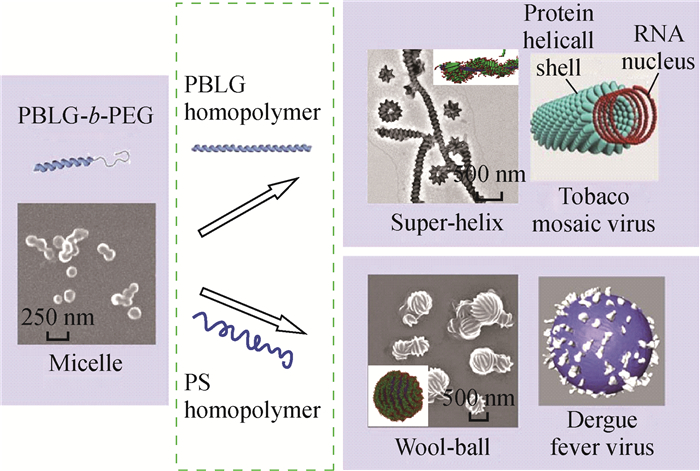诊疗药物如基因、蛋白质等需要在细胞内部环境中才能有效地发挥作用,制备合适的载体将这些诊疗药物高效安全地送入细胞是一项重要的挑战。自然界中的病毒具有高效的细胞内化能力,但是直接使用天然病毒来源的载体具有安全风险。模仿病毒的结构特征,通过聚合物自组装构建的仿病毒粒子同样表现出良好的细胞内化能力和药物控释性能。需要注意的是,病毒的高效细胞内化能力与其特定的表面微结构有关;目前对于仿病毒粒子表面微结构的研究较少,因此构建具有规整表面微结构的仿病毒粒子,研究表面微结构对其细胞内化行为的影响显得尤为重要。华东理工大学蔡春华博士及其团队的研究表明刚柔聚肽嵌段共聚物与均聚物共混自组装是制备仿病毒粒子的有效方法,近年来他们持续开展了相关研究,取得了一系列重要进展。本文对他们的研究作了简要的评述。
2009年,蔡春华等通过聚(γ-苄基L-谷氨酸酯)-嵌段-聚(乙二醇)(PBLG-b-PEG)嵌段共聚物与PBLG均聚物共混自组装,制备了规整的超分子螺旋,包括螺旋棒和螺旋环,并且手性均为右旋[1](示意图见图 1)。此后,他们系统研究了该自组装体系的结构和形成机理。该体系的驱动力非常复杂,涉及疏水-疏水、π-π、PBLG刚性链段取向排列等多种作用力,实验研究存在一定的困难。因此,他们首先利用模拟方法对该体系作了研究,证实这些超分子螺旋是由rod-coil(刚-柔)嵌段共聚物在rod均聚物表面螺旋排列形成的[2]。若增强rod-rod链段之间的作用力,则超分子螺旋形貌转变为算珠状。随后,在模拟预测结果的指导下,他们有针对性地开展了实验研究。通过升高实验温度,PBLG-b-PEG/PBLG共混体系自组装形成了与模拟结果非常相似的算珠状结构。接着,通过控制溶剂性质和温度等自组装条件,进一步实现了超分子螺旋手性的右旋-左旋的完全转变,两种手性螺旋结构以无手性的算珠状结构分开[3]。超分子螺旋的股数也可以通过改变组装条件得到有效调控[4]。另一方面,他们研究了聚合物链段刚柔性对组装结构的影响[2, 5-7]。将刚性的PBLG均聚物换成相对柔性的聚苯乙烯(PS)均聚物,PBLG-b-PEG/PS共混体系自组装形成了新颖的毛线球状结构[2, 5]。这些毛线球状结构由PS均聚物形成球形内核,PBLG-b-PEG在聚集体表面形成条带[6]。将PS均聚物化学改性引入特定官能基团,调节其与PBLG链段之间的作用强度,可以调控毛线球表面的条纹高度和结构[7]。

|
图 1 聚肽嵌段共聚物/均聚物共混体系自组装形成超分子螺旋和毛线球状仿病毒粒子 Fig. 1 Polypeptide block copolymer/homopolymer mixtures self-assembled into virus-mimetic super-helices and wool-balls |
自然界中的病毒以DNA或RNA为内核,蛋白质亚基在表面有序排列形成衣壳。从形态和结构上看,这些超分子螺旋和毛线球状聚集体的结构分别与棒状和球形病毒的结构类似,可以作为仿病毒材料开展相关性能研究。最近,他们通过PBLG-b-PEG/PBLG共混自组装,构建了具有不同表面结构的棒状仿病毒粒子,包括螺旋棒、算珠状棒和光滑棒,研究了这些棒状仿病毒粒子的细胞内化行为[8]。研究表明,表面微结构对其细胞内化行为有很大影响:螺旋棒的内化速率最快,光滑棒次之,而算珠状棒最慢。另外,据了解,他们还证实在相同的流体力学体积下,棒状仿病毒粒子的内化速率显著大于球形仿病毒粒子的内化速率。
需要强调的是,上述共聚物/均聚物共混体系自组装过程本质上是界面自组装:均聚物首先聚集形成棒状或球形模板,嵌段共聚物在模板表面自组装形成表面微结构。由于均聚物形成的模板粒子大小不均匀,使制备的聚集体均匀性较差,这将对材料的实际应用带来不利影响。因此,使用直接的模板粒子不失为一种有效的解决方法。实际上,他们最近利用PBLG-b-PEG嵌段共聚物在碳纳米管(CNT)表面自组装,不仅实现了CNT在水中的分散,还在CNT表面构建了螺旋、陀螺、球、环等多种表面纳米结构[9]。
综上所述,蔡春华团队模仿天然病毒粒子的结构和性能,提出了聚肽嵌段共聚物与均聚物共混自组装构建仿病毒粒子的新方法,不仅实现了病毒粒子形貌和表面微结构的模仿,还表现出与病毒类似的高效细胞内化行为。他们的研究工作很好地推进了仿病毒粒子材料的结构与性能研究,为高性能药物载体的制备奠定了基础。
| [1] | CAI C H, LIN J P, CHEN T, et al. Super-helices self-assembled from a binary system of amphiphilic polypeptide block copolymers and polypeptide homopolymers[J]. Chemical Communications, 2009(19): 2709–2711. DOI:10.1039/b823367e |
| [2] | CAI C H, LI Y L, LIN J P, et al. Simulation-assisted self-assembly of multicomponent polymers into hierarchical assemblies with varied morphologies[J]. Angewandte Chemie:International Edition, 2013, 52(30): 7732–7736. DOI:10.1002/anie.v52.30 |
| [3] | CAI C H, LIN J P, ZHU X Y, et al. Superhelices with designed helical structures and temperature-stimulated chirality transitions[J]. Macromolecules, 2016, 49(1): 15–22. DOI:10.1021/acs.macromol.5b02254 |
| [4] | ZHU X Y, LIN J P, CAI C H. Superhelices self-assembled from polypeptide-based polymer mixtures:Multi-stranded feature[J]. Chemistry:An Asian Journal, 2017, 12(2): 224–232. DOI:10.1002/asia.v12.2 |
| [5] | ZHU X Y, GUAN Z, LIN J P, et al. Strip-pattern-spheres self-assembled from polypeptide-based polymer mixtures:Structure and defect features[J]. Scientific Reports, 2016, 6: 29796. DOI:10.1038/srep29796 |
| [6] | ZHANG S, CAI C H, GUAN Z, et al. Fabrication of virus-like particles with strip-pattern surface:A two-step self-assembly approach[J]. Chinese Chemistry Letters, 2017, 28(4): 839–844. DOI:10.1016/j.cclet.2016.12.040 |
| [7] | 张朔, 蔡春华, 黄琪婧, 等. 分子间相互作用对聚肽共聚物/聚苯乙烯衍生物共混体系自组装形貌影响的研究[J]. 高分子学报, 2018(1): 109–118. |
| [8] | XUE J X, GUAN Z, LIN J P, et al. Cellular internalization of rod-like nanoparticles with various surface patterns:Novel entry pathway and controllable uptake capacity[J]. Small, 2017, 13(24): 1604214. DOI:10.1002/smll.201604214 |
| [9] | HAN Y, CAI C H, LIN J P, et al. Self-assembly of rod-coil block copolymers on carbon nanotubes:A route towards diverse surface nanostructures[J]. Macromolecular Rapid Communications, 2018. DOI:10.1002/marc.201800080 |
 2018, Vol. 31
2018, Vol. 31

